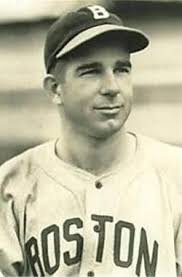Baseball player
| Bama Rowell | |
|---|---|
 | |
| Second baseman / Outfielder | |
| Born: (1916-01-13)January 13, 1916 Citronelle, Alabama, U.S. | |
| Died: August 16, 1993(1993-08-16) (aged 77) Citronelle, Alabama, U.S. | |
| Batted: LeftThrew: Right | |
| MLB debut | |
| September 4, 1939, for the Boston Bees | |
| Last MLB appearance | |
| October 2, 1948, for the Philadelphia Phillies | |
| MLB statistics | |
| Batting average | .275 |
| Home runs | 19 |
| Runs batted in | 217 |
| Stats at Baseball Reference | |
| Teams | |
| |
Carvel William "Bama" Rowell (January 13, 1916 – August 16, 1993) was an American professional baseball player. In Major League Baseball, he was a second baseman and outfielder for the Boston Bees/Braves (1939–41 and 1946–47) and Philadelphia Phillies (1948). Rowell was a native and lifelong resident of Citronelle, Alabama. He batted left-handed, threw right-handed, stood 5 feet 11 inches (1.80 m) tall and weighed 185 pounds (84 kg).
He finished 21st in voting for the 1940 National League Most Valuable Player for playing in 130 games and having 486 at bats, 46 runs scored, 148 hits, 19 doubles, eight triples, three home runs, 58 runs batted in, 12 stolen bases, 18 walks, .305 batting average, .331 on-base percentage, .395 slugging percentage, 192 total bases and three sacrifice hits.
In six MLB seasons Rowell played in 574 games and had 1,901 at bats, 200 runs scored, 523 hits, 95 doubles, 26 triples, 19 home runs, 217 runs batted in, 37 stolen bases, 113 walks, a .275 batting average, a .316 on-base percentage, and a .382 slugging percentage, with 727 total bases and 27 sacrifice hits.
On May 30, 1946 at 4:25 P.M., Rowell hit a home run which broke the Bulova clock on the Ebbets Field scoreboard, shattering the clock's glass. The clock stopped exactly one hour later. Although Bulova promised a free watch to anyone who hit the clock, Rowell didn't receive his watch until 41 years later, on Bama Rowell day in Citronelle.
On March 6, 1948, Rowell was involved in a key trade for the Braves. He was swapped to the Brooklyn Dodgers with first baseman Ray Sanders and $40,000 for second baseman Eddie Stanky. Although Rowell spent only eleven days with Brooklyn before being sold to the Phillies on March 17, Stanky helped lead Boston to its first National League pennant since 1914.
References
- ^ "Bama Rowell". Baseball-reference.com. Baseball Reference. Retrieved December 29, 2019.
- Lowry, Philip (2006). Green Cathedrals. Walker & Company. p. 40. ISBN 978-0-8027-1608-8.
- "Higbe 5-Hitter Stops Braves, 5-0, Then Dodgers Drop 10-8 Decision – Biggest Ebbets Field Crowd of Year, 36,854 Sees Boston Score 7 Runs in 2d Inning of Nightcap – Brooks Hold Lead Over Cards". The New York Times. May 31, 1946. p. 15. Retrieved December 29, 2019.
- Thomas Jr., Robert McG.; Lloyd, Barbara (August 3, 1987). "Time Catches Up". The New York Times. p. C2. Retrieved December 29, 2019.
- McGowen, Roscoe (March 7, 1948). "Stanky of Dodgers Traded to Braves for Sanders, Cash – Brooklyn Gets First Baseman and an Undisclosed Sum for Eddie, Who Has Pneumonia – Deal Comes As Surprise – Durocher Selects Miksis for Second – Robinson Stil at First, Manager Declares". The New York Times. p. S1. Retrieved December 29, 2019.
- "Rowell Goes to Phils – Rickey Allowed Outfielder to Make Deal for Himself". The New York Times. Associated Press. March 19, 1948. Retrieved December 29, 2019.
External links
- Career statistics from Baseball Reference, or Baseball Reference (Minors)
- Bama Rowell at Find a Grave
- 1916 births
- 1993 deaths
- Baseball players from Alabama
- Boston Bees players
- Boston Braves players
- Cocoa Indians players
- Cordele Reds players
- Dayton Ducks players
- DeLand Red Hats players
- Hartford Bees players
- Louisiana State University alumni
- Major League Baseball second basemen
- Major League Baseball left fielders
- Minneapolis Millers (baseball) players
- Minor league baseball managers
- Mobile Bears players
- People from Mobile County, Alabama
- Philadelphia Phillies players
- Winston-Salem Twins players
- 20th-century American sportsmen